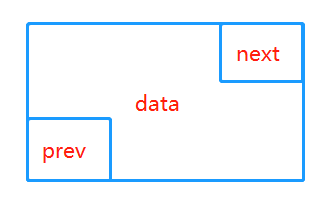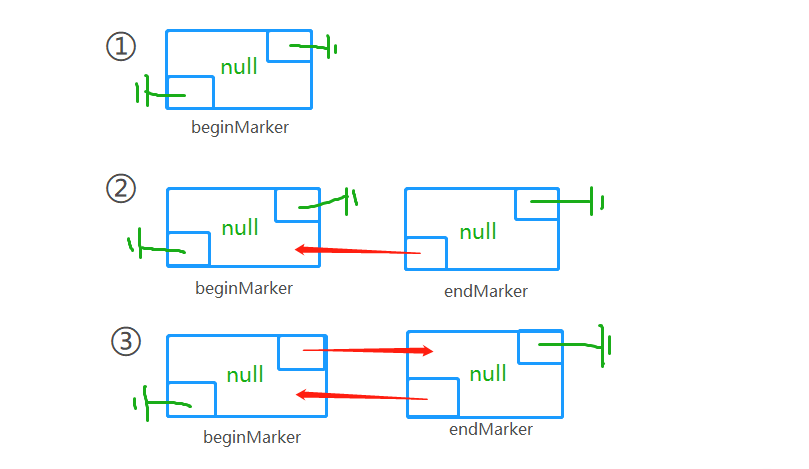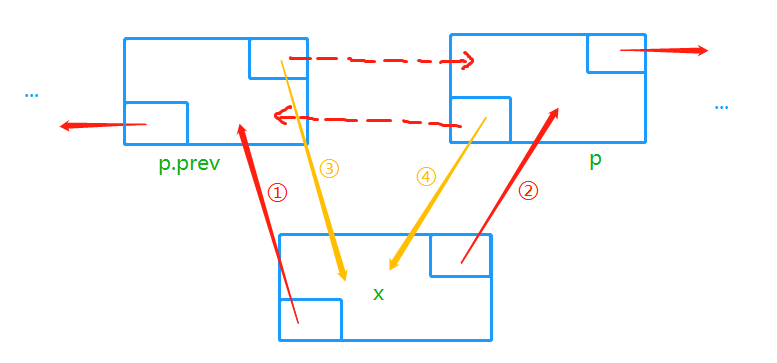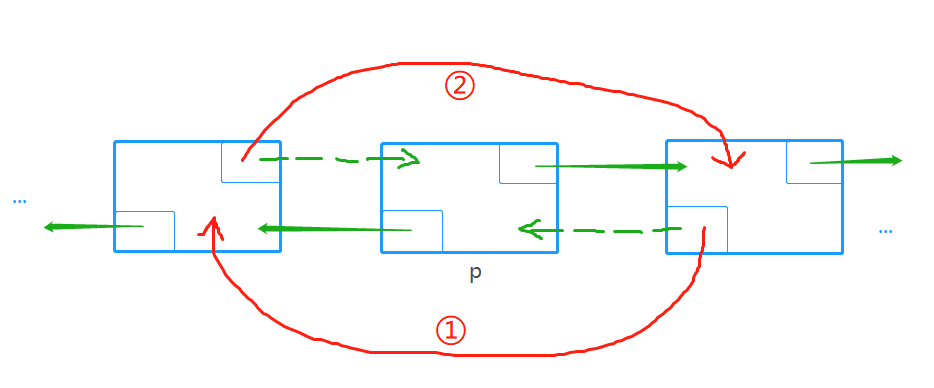自己动手撸一个LinkedList
自己动手撸一个LinkedList
1. 原理
LinkedList是基于双链表的动态数组,数据添加删除效率高,只需要改变指针指向即可,但是访问数据的平均效率低,需要对链表进行遍历。因此,LinkedList善于进行一些插入、删除操作,不利于进行检索操作。LinkedList和ArrayList这两个list在我们代码里会经常用到,因此,小编自定义实现LinkedList的简易版--MyLinkedList。
2. public API
void clear() --> 置空
boolean isEmpty() --> 判空
int size() --> 返回链表的长度
AnyType get(int idx) --> 根据索引检索元素
AnyType set(int idx) --> 根据索引跟新元素
boolean add(AnyType x) --> 添加元素x
boolean add(AnyType x,int idx) --> 根据索引添加元素x
AnyType remove(int idx) --> 根据索引删除元素x
String toString() --> 打印链表
3. 图解核心操作
-
一个节点Node类的数据结构

-
doClear( ) 方法,初始化一个双链表,先定义一个头结点beginMarker,然后定义一个尾结点endMarker,前驱指向头结点,最后头结点的后继指向尾结点。

-
添加元素,先定义一个被添加元素x的节点,使它前驱指向被插入位置的前一个,后继指向被插入位置的节点,这是第一步,然后将被插入的前一个节点的next指向此节点,被插入位置的节点的prev指向此节点。

Node<AnyType> newNode = new Node<>(x, p.prev, p); // ①②
newNode.prev.next = newNode; // ③
p.prev = newNode; // ④当然,第三步和第四步可以合并:
Node<AnyType> newNode = new Node<>(x, p.prev, p); // ①②
p.prev = p.prev.next = newNode; // ③④没想到以上4步全可以合并为:
p.prev = p.prev.next = new Node<>(x, p.prev, p); // ①②③④
精辟!
-
删除元素,根据索引找到对应的节点p,将p的后继的prev指向p的前驱,将p的前驱的next指向p的后继。

p.next.prev = p.prev;
p.prev.next = p.next;
-
检索节点getNode,LinkedList可以很快很方便地插入和删除元素,但是对于检索元素则就慢了,我们可以将索引分为前半部分和后半部分,如果索引在前半部分,我们就向后的方向遍历该链表;同样的道理,如果索引在后半部分,我们就从终端开始往回走,向前遍历该链表,这样可以提高一下检索速度吧。
// 从头结点开始向后找
if (idx < size() / 2) {
p = beginMarker.next;
for (int i = 0; i < idx; i++) {
p = p.next;
}
}
// 从尾节点开始向前找
else {
p = endMarker;
for (int i = size(); i > idx; i--) {
p = p.prev;
}
}
4. MyLinkedList代码实现
package com.hx.list;
/**
* @author: wenhx
* @date: Created in 2019/10/17 16:11
* @description: 用双链表实现MyLinkedList
*/
public class MyLinkedList<AnyType> implements Iterable<AnyType> {
private int theSize;
private int modCount = 0;
private Node<AnyType> beginMarker;
private Node<AnyType> endMarker;
/**
* 内部类,定义链表的节点
*/
private static class Node<AnyType> {
public AnyType data;
public Node<AnyType> prev;
public Node<AnyType> next;
public Node(AnyType d, Node<AnyType> p, Node<AnyType> n) {
data = d;
prev = p;
next = n;
}
}
/**
* 构造器
*/
public MyLinkedList() {
doClear();
}
/**
* 判空
*/
public boolean isEmpty() {
return size() == 0;
}
/**
* 清空
*/
public void clear() {
doClear();
}
/**
* 返回链表的长度
*/
public int size() {
return theSize;
}
/**
* 根据索引检索元素
*/
public AnyType get(int idx) {
return getNode(idx).data;
}
/**
* 根据索引跟新元素
*/
public AnyType set(int idx, AnyType newVal) {
Node<AnyType> p = getNode(idx);
AnyType oldVal = p.data;
p.data = newVal;
return oldVal;
}
/**
* 添加元素x
*/
public boolean add(AnyType x) {
add(size(), x);
return true;
}
/**
* 根据索引添加元素
*/
public void add(int idx, AnyType x) {
addBefore(getNode(idx, 0, size()), x);
}
/**
* 根据索引删除元素
*/
public AnyType remove(int idx) {
return remove(getNode(idx));
}
/**
* 打印链表
*/
public String toString() {
StringBuilder sb = new StringBuilder("[ ");
for (AnyType x : this) {
sb.append(x + " ");
}
sb.append("]");
return new String(sb);
}
/**
* 清空链表(实现)
*/
private void doClear() {
beginMarker = new Node<>(null, null, null);
endMarker = new Node<>(null, beginMarker, null);
beginMarker.next = endMarker;
theSize = 0;
modCount++;
}
/**
* 根据索引检索节点
*/
private Node<AnyType> getNode(int idx) {
return getNode(idx, 0, size() - 1);
}
/**
* 检索节点
*/
private Node<AnyType> getNode(int idx, int lower, int upper) {
Node<AnyType> p;
if (idx < lower || idx > upper) {
throw new IndexOutOfBoundsException("getNode index: " + idx + "; size: " + size());
}
if (idx < size() / 2) {
p = beginMarker.next;
for (int i = 0; i < idx; i++) {
p = p.next;
}
} else {
p = endMarker;
for (int i = size(); i > idx; i--) {
p = p.prev;
}
}
return p;
}
/**
* 插入节点
*/
private void addBefore(Node<AnyType> p, AnyType x) {
Node<AnyType> newNode = new Node<>(x, p.prev, p);
newNode.prev.next = newNode;
p.prev = newNode;
theSize++;
modCount++;
}
/**
* 删除节点p
*/
private AnyType remove(Node<AnyType> p) {
p.next.prev = p.prev;
p.prev.next = p.next;
theSize--;
modCount++;
return p.data;
}
/**
* 返回一个迭代器对象,用于遍历链表
*/
public java.util.Iterator<AnyType> iterator() {
return new LinkedListIterator();
}
/**
* LinkedListIterator迭代器的实现
*/
private class LinkedListIterator implements java.util.Iterator<AnyType> {
private Node<AnyType> current = beginMarker.next;
private int expectedModCount = modCount;
private boolean okToRemove = false;
public boolean hasNext() {
return current != endMarker;
}
public AnyType next() {
if (modCount != expectedModCount) {
throw new java.util.ConcurrentModificationException();
}
if (!hasNext()) {
throw new java.util.NoSuchElementException();
}
AnyType nextItem = current.data;
current = current.next;
okToRemove = true;
return nextItem;
}
public void remove() {
if (modCount != expectedModCount) {
throw new java.util.ConcurrentModificationException();
}
if (!okToRemove) {
throw new IllegalStateException();
}
MyLinkedList.this.remove(current.prev);
expectedModCount++;
okToRemove = false;
}
}
/**
* 主方法:用来测试MyLinkedList
*/
public static void main(String[] args) {
MyLinkedList<Integer> myLinkedList = new MyLinkedList<>();
for (int i = 0; i < 10; i++) {
myLinkedList.add(i);
}
for (int i = 20; i < 30; i++) {
myLinkedList.add(0, i);
}
System.out.println(myLinkedList.toString());
System.out.println("----------");
myLinkedList.remove(0);
myLinkedList.remove(myLinkedList.size() - 1);
System.out.println(myLinkedList);
System.out.println("----------");
java.util.Iterator<Integer> itr = myLinkedList.iterator();
while (itr.hasNext()) {
itr.next();
itr.remove();
System.out.println(myLinkedList);
}
}
}
完成,撒花,一个迷你版的LinkedList就写好啦,下次有空再写一个迷你版的ArrayList...
后记:
若有不当之处,可向小编反馈,一起交流学习,共同进步。
个人博客地址:https://www.cnblogs.com/q964024886/
GitHub地址:https://github.com/wenhaixiong
- 自己动手系列——实现一个简单的LinkedList
- 自己动手系列——实现一个简单的LinkedLis
- 根据链表的原理,自己实现一个简易版的LinkedList
- 自己实现了一个LinkedList对照源码一看,呵呵呵
- 自己写的一个linkedList
- 自己实现一个泛型LinkedList
- 自己动手系列——实现一个简单的LinkedLis
- 自己写的一个linkedList
- 自己动手实现一个C#中List
- 自己动手系列——实现一个简单的LinkedLis
- 自己动手系列——实现一个简单的LinkedLis
- 如何自己写一个ArrayList、LinkedList和HashSet集合?
- 【LinkedList原理】自己动手实现简单LinkList以及增删改查。
- 应用抽象工厂模式自己动手写一个ioc
- 自己动手撸一个Handler
- 自己动手实现一个队列LGQueue
- 自己动手开发一个 Web 服务器(三)
- 主题:自己动手写一个Spring (Spring 到底是怎么跑起来的)
- 《SSO系列二》自己动手写一个SSO
- 自己动手实现一个简单的string类(二)
